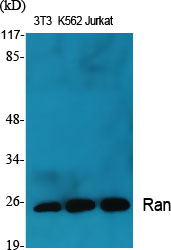
Catalog: YT3998
Size
Price
Status
Qty.
200μL
$450.00
In stock
0
100μL
$280.00
In stock
0
40μL
$150.00
In stock
0
Add to cart


Collected


Collect
Main Information
Target
Ran
Host Species
Rabbit
Reactivity
Human, Mouse, Rat
Applications
WB, IHC, IF, ELISA
MW
25kD (Observed)
Conjugate/Modification
Unmodified
Detailed Information
Recommended Dilution Ratio
WB 1:500-1:2000; IHC 1:100-1:300; ELISA 1:10000; IF 1:50-200
Formulation
Liquid in PBS containing 50% glycerol, 0.5% BSA and 0.02% sodium azide.
Specificity
Ran Polyclonal Antibody detects endogenous levels of Ran protein.
Purification
The antibody was affinity-purified from rabbit antiserum by affinity-chromatography using epitope-specific immunogen.
Storage
-15°C to -25°C/1 year(Do not lower than -25°C)
Concentration
1 mg/ml
MW(Observed)
25kD
Modification
Unmodified
Clonality
Polyclonal
Isotype
IgG
Related Products
Antigen&Target Information
Immunogen:
The antiserum was produced against synthesized peptide derived from human RAN. AA range:167-216
show all
Specificity:
Ran Polyclonal Antibody detects endogenous levels of Ran protein.
show all
Gene Name:
RAN
show all
Protein Name:
GTP-binding nuclear protein Ran
show all
Other Name:
RAN ;
ARA24 ;
OK/SW-cl.81 ;
GTP-binding nuclear protein Ran ;
Androgen receptor-associated protein 24 ;
GTPase Ran ;
Ras-like protein TC4 ;
Ras-related nuclear protein
ARA24 ;
OK/SW-cl.81 ;
GTP-binding nuclear protein Ran ;
Androgen receptor-associated protein 24 ;
GTPase Ran ;
Ras-like protein TC4 ;
Ras-related nuclear protein
show all
Database Link:
Background:
RAN (ras-related nuclear protein) is a small GTP binding protein belonging to the RAS superfamily that is essential for the translocation of RNA and proteins through the nuclear pore complex. The RAN protein is also involved in control of DNA synthesis and cell cycle progression. Nuclear localization of RAN requires the presence of regulator of chromosome condensation 1 (RCC1). Mutations in RAN disrupt DNA synthesis. Because of its many functions, it is likely that RAN interacts with several other proteins. RAN regulates formation and organization of the microtubule network independently of its role in the nucleus-cytosol exchange of macromolecules. RAN could be a key signaling molecule regulating microtubule polymerization during mitosis. RCC1 generates a high local concentration of RAN-GTP around chromatin which, in turn, induces the local nucleation of microtubules. RAN is an androgen re
show all
Function:
Function:Enhances AR-mediated transactivation. Transactivation decreases as the poly-Gln length within AR increases.,Function:GTP-binding protein involved in nucleocytoplasmic transport. Required for the import of protein into the nucleus and also for RNA export. Involved in chromatin condensation and control of cell cycle.,PTM:The N-terminus is blocked.,similarity:Belongs to the small GTPase superfamily. Ran family.,subcellular location:Becomes dispersed throughout the cytoplasm during mitosis. Identified by mass spectrometry in melanosome fractions from stage I to stage IV.,subunit:Monomer. Also forms a complex with CHC1 and interacts with the AR N-terminal poly-Gln region. The interaction with AR is inversely correlated with the poly-Gln length. Part of a complex consisting of RANBP9, Ran, DYRK1B and COPS5. Found in a nuclear export complex with RANBP3 and XPO1. Component of a nuclear export receptor complex composed of KPNB1, Ran, SNUPN and XPO1. Found in a trimeric export complex with SNUPN, Ran and XPO1. Interacts with RANBP10. In case of HIV-1 infection, found in a complex with HIV-1 Rev, RNAs containing a Rev response element (RRE) and XPO1. Found in a complex with HTLV-1 Rex, RANBP3 and XPO1.,tissue specificity:Expressed in a variety of tissues.,
show all
Cellular Localization:
Nucleus . Nucleus envelope . Cytoplasm, cytosol . Cytoplasm . Melanosome . Predominantly nuclear during interphase (PubMed:8421051, PubMed:12194828, PubMed:10679025). Becomes dispersed throughout the cytoplasm during mitosis (PubMed:8421051, PubMed:12194828). Identified by mass spectrometry in melanosome fractions from stage I to stage IV (PubMed:17081065). .
show all
Tissue Expression:
Expressed in a variety of tissues.
show all
Research Areas:
>>Ribosome biogenesis in eukaryotes ;
>>Nucleocytoplasmic transport ;
>>Viral life cycle - HIV-1 ;
>>Human T-cell leukemia virus 1 infection
>>Nucleocytoplasmic transport ;
>>Viral life cycle - HIV-1 ;
>>Human T-cell leukemia virus 1 infection
show all
Reference Citation({{totalcount}})
Catalog: YT3998
Size
Price
Status
Qty.
200μL
$450.00
In stock
0
100μL
$280.00
In stock
0
40μL
$150.00
In stock
0
Add to cart


Collected


Collect
Recently Viewed Products
Clear allPRODUCTS
CUSTOMIZED
ABOUT US
Toggle night Mode
{{pinfoXq.title || ''}}
Catalog: {{pinfoXq.catalog || ''}}
Filter:
All
{{item.name}}
{{pinfo.title}}
-{{pinfo.catalog}}
Main Information
Target
{{pinfo.target}}
Reactivity
{{pinfo.react}}
Applications
{{pinfo.applicat}}
Conjugate/Modification
{{pinfo.coupling}}/{{pinfo.modific}}
MW (kDa)
{{pinfo.mwcalc}}
Host Species
{{pinfo.hostspec}}
Isotype
{{pinfo.isotype}}
Product {{index}}/{{pcount}}
Prev
Next
{{pvTitle}}
Scroll wheel zooms the picture
{{pvDescr}}




















